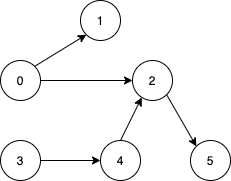- {x}
- The Most Recent Orders for Each Product
- Three Consecutive Odds
- Minimum Operations to Make Array Equal
- Magnetic Force Between Two Balls
- Minimum Number of Days to Eat N Oranges
- Strings Differ by One Character
- Bank Account Summary
- Thousand Separator
- Minimum Number of Vertices to Reach All Nodes
- Minimum Numbers of Function Calls to Make Target Array
- Detect Cycles in 2D Grid
- Most Visited Sector in a Circular Track
- Maximum Number of Coins You Can Get
- Find Latest Group of Size M
- Stone Game V
- Put Boxes Into the Warehouse I
- Unique Orders and Customers Per Month
- Read More...

Minimum Number of Vertices to Reach All Nodes
Given a directed acyclic graph, with n vertices numbered from 0 to n-1, and an array edges where edges[i] = [fromi, toi] represents a directed edge from node fromi to node toi.
Find the smallest set of vertices from which all nodes in the graph are reachable. It's guaranteed that a unique solution exists.
Notice that you can return the vertices in any order.
Example 1:

Input: n = 6, edges = [[0,1],[0,2],[2,5],[3,4],[4,2]] Output: [0,3] Explanation: It's not possible to reach all the nodes from a single vertex. From 0 we can reach [0,1,2,5]. From 3 we can reach [3,4,2,5]. So we output [0,3].
Example 2:

Input: n = 5, edges = [[0,1],[2,1],[3,1],[1,4],[2,4]] Output: [0,2,3] Explanation: Notice that vertices 0, 3 and 2 are not reachable from any other node, so we must include them. Also any of these vertices can reach nodes 1 and 4.
Constraints:
2 <= n <= 10^51 <= edges.length <= min(10^5, n * (n - 1) / 2)edges[i].length == 20 <= fromi, toi < n- All pairs
(fromi, toi)are distinct.
Solution Explanation
This problem asks to find the minimum set of vertices in a directed acyclic graph (DAG) such that all nodes in the graph are reachable from these vertices. The solution leverages the fact that a vertex that is a destination of an edge (incoming edge) does not need to be in the minimum set because it's reachable from its predecessors. Therefore, only vertices with no incoming edges are considered.
Approach
The core idea is to count the number of incoming edges for each vertex. If a vertex has zero incoming edges, it must be included in the minimum set because it cannot be reached from any other vertex. Vertices with incoming edges can be reached from other vertices, so they don't need to be explicitly included in the result.
Algorithm
-
Initialization: Create an array
cntof sizen(number of vertices) initialized to 0. This array will store the count of incoming edges for each vertex. -
Count Incoming Edges: Iterate through the
edgeslist. For each edge[from, to], increment the count of incoming edges for vertexto(cnt[to]++). -
Identify Source Vertices: Iterate through the
cntarray. Ifcnt[i]is 0, it means vertexihas no incoming edges, so add it to the result listans. -
Return Result: Return the
anslist containing the vertices with no incoming edges.
Time and Space Complexity
-
Time Complexity: O(N + E), where N is the number of vertices and E is the number of edges. The algorithm iterates through the edges once (O(E)) and then iterates through the vertices once (O(N)).
-
Space Complexity: O(N). The
cntarray requires O(N) space to store the incoming edge counts for each vertex. Theanslist also requires at most O(N) space in the worst case.
Code Explanation (Python)
from collections import Counter
class Solution:
def findSmallestSetOfVertices(self, n: int, edges: List[List[int]]) -> List[int]:
cnt = Counter(t for _, t in edges) #Efficient way to count incoming edges using Counter
return [i for i in range(n) if cnt[i] == 0] #List comprehension for concise code
The Python solution utilizes the Counter object from the collections module for efficient counting of incoming edges. This eliminates the need for manual iteration and makes the code more readable and potentially faster. The list comprehension elegantly filters and creates the result list.
Other languages follow a similar logic, but the specific syntax and data structures might vary slightly. The core algorithm remains consistent across all languages.